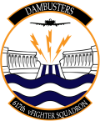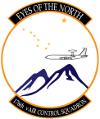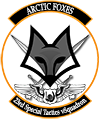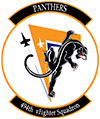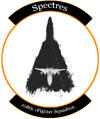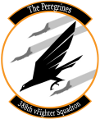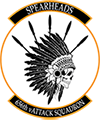Training Program Overview
Purpose: The 132nd Virtual Wing Training Program (132-TRP or TRP) is designed to help new pilots fully learn the systems and procedures for their chosen airframe, and make them ready for participation in Combat missions as quickly as possible. The TRP ensures that everyone participating in our Combat missions is using the same SOPs and tactics, and that they are flying to the same standard.
Eligibility: 132nd Virtual Wing is looking for experienced pilots who already understand the systems and procedures for their aircraft.. The TRP is designed to train the 132nd Virtual Wing procedures and tactics, and how to fly and communicate in a multiplayer environment. We recommend that potential applicants who are new to DCS learn their airframe in the single player training missions, and only apply once they are comfortable with all the skills required to fly the aircraft – including air-to-air refuelling and carrier operations, where applicable.
Each squadron has its own airframe-specific training program. All TRPs follow the same general outline:
Initial Qualification Training (IQT): The goal of IQT is airframe familiarisation, basic flight and systems training, demonstrating that the trainee pilot to operate the aircraft and its systems independently. IQT provides a solid basis for further solo practice. IQT certification will usually be a requirement for any operation hosted by the 132nd. Pilots will be allowed to self-certify for most of the material in the IQT category.
Mission Qualification Training (MQT): The goal of MQT is to train skills that enable the pilot to more effectively support his squadron during operations, e.g. proper communications, lead/wing tactical manoeuvring, weapons employment, joint operations etc. MQT will be a requirement to participate in Combat mission as a qualified wingman. However, an Instructor Pilot can have a student pilot as his wingman during a Combat mission. After completion of IQT and MQT, the trainee will be awarded their pilot wings, and they be qualified to participate in our Combat missions as a wingman.
Continuation Training (CT) The Continuation Training phase contains specific tracks that trains pilots in specialised mission roles.
- 2-ship flight lead: qualifies the pilot to fly as a 2-ship flight lead, including element lead in a 4-ship
- 4-ship flight lead: qualifies the pilot to fly as a 4-ship flight lead
- FAC(A): This is an upgrade for an experienced pilot (2-ship lead as a minimum) and gives them training in the FAC(A) role. After completion of this upgrade the pilot will be a valuable resource to the Wing when running CAS operations and JTAC/FAC(A) Tactics, Techniques and Procedures (TTP).
- Instructor pilot (IP): Instructor Pilot (IP) upgrade is an upgrade for en experienced pilot (2-ship lead as a minimum) to work as an instructor and educate new pilots in 132-TRP.
We expect all pilots to progress their Continuation Training to gain their 2-ship flight lead qualification as a minimum.
We expect a commitment of 3-4 training flights per month as a minimum during the training period. If a trainee pilot is absent for more than four weeks, they will be removed (“benched”) from the training programme to allow another trainee to start. If the trainee signs up for instruction, but there are no IPs available, then this four-week rule will not apply.
Pilot Qualifications
Each pilot will have their own page listing their qualifications. The page lists the progression along the TRP(s) that the pilot belongs to.
Self qualification: The TRP is designed so that pilots can self-qualify for lessons that they can master in the single player training missions, saving on IP time.
The 132nd encourages all trainees to independently study and practice their skills. If a pilot considers themselves proficient with a certain lesson material, they may check the "Self-qualification" checkbox for that lesson. By doing so the pilot:
- Confirms that they have read the specified TRP lesson contents and have understood it in full.
- Confirms that they have spent a sufficient amount of self-study and self-practice required to become reasonably proficient both in theory and practice of the topics covered by the specified lesson.
- Confirms that they are ready for an IP review their skills based on observations of their performance during one of the mandatory IP check rides in the TRP arcs.
The lessons that trainees self-qualify for will be evaluated during the IP-mandatory check rides. For all intents and purposes the lesson will count as if the pilot has passed it, but if during an IP check ride it is clear that the trainee has not fully grasped a particular skill, the IP can recommend that they practice / study some more before be cleared to the next stage of the TRP.
Mandatory lessons: At least one lesson per training phase will be mandatory to fly under instruction. This lesson will usually be the last lesson remaining to complete the specific training phase and therefore serves as a sort of exam. Pilots may not self-qualify for these mandatory lessons. Grades will be assigned after the mandatory lesson has been completed.
Request Instruction: Pilots should use the "Request Instruction" checkbox when ready to fly an IP-mandatory flight; in addition they should also post in the Event Comms Chatter that they are requesting an IP, and which lesson they are requesting to fly.
Grades: Grades are assigned as follows:
- Q (qualified) — fully qualified
- Q- (qualified minus) — qualified with corrective remarks; further self study and practice is recommended
- U (unqualified) — did not meet requirements; this can be due to events outside their control, which will be covered in the debrief notes
We expect a lot from our trainees, and once they reach pilot status (IQT and MQT certifications) they can proudly say that they have what it takes to be a 132nd virtual pilot. This ensures that we can fully trust in our pilots' abilities and performance during missions. Pilots who receive a U grade should consider this an opportunity to learn more, study deeper and further hone your skills! The IP will give specific feedback indicating which parts of the lesson needs more work.
A Q- may, after further study and practice, be re-submitted for evaluation and be polished to a perfect Q.
